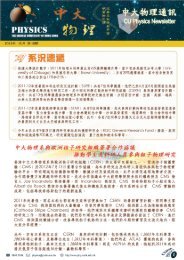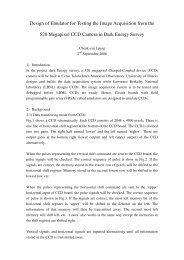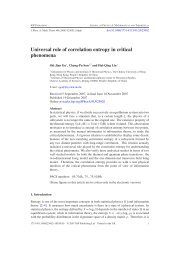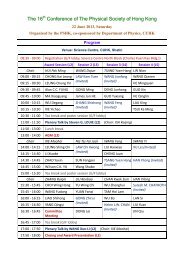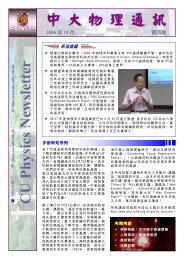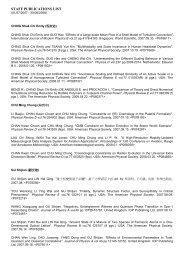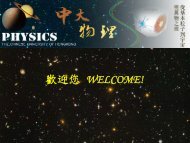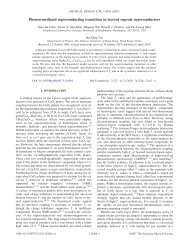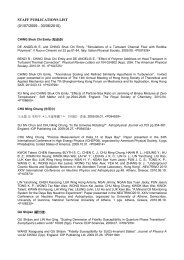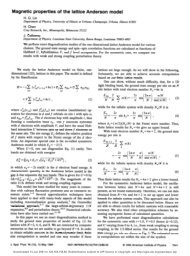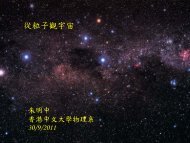Constructing soluble quantum spin models - Department of Physics ...
Constructing soluble quantum spin models - Department of Physics ...
Constructing soluble quantum spin models - Department of Physics ...
You also want an ePaper? Increase the reach of your titles
YUMPU automatically turns print PDFs into web optimized ePapers that Google loves.
H.Y. Shik et al. / Nuclear <strong>Physics</strong> B 666 [FS] (2003) 337–360 339<br />
where [i, i ′ ] denotes a normalized <strong>spin</strong> singlet with |S i + S ′ i<br />
|=0, e.g., for the <strong>spin</strong>-1/2<br />
case,<br />
[i, i ′ ]= 1 √<br />
2<br />
( |↑i ↓ i ′〉−|↓ i ↑ i ′〉 ) ,<br />
(6)<br />
(i, i ′ ) denotes a normalized non-singlet such as triplet or pentad with |S i + S ′ i<br />
|=m ≠ 0,<br />
e.g., for the <strong>spin</strong>-1/2 case and m = 1<br />
(i, i ′ ) =− 1 √<br />
2<br />
( |↑i ↑ i ′〉−|↓ i ↓ i ′〉 ) ,<br />
i<br />
√<br />
2<br />
(<br />
|↑i ↑ i ′〉+|↓ i ↓ i ′〉 ) ,<br />
or<br />
or<br />
1<br />
√<br />
2<br />
(<br />
|↑i ↓ i ′〉+|↓ i ↑ i ′〉 ) ,<br />
(7)<br />
and {✷} denotes the four-<strong>spin</strong> plaquette singlet with |S i + S ′ i + S i+1 + S ′ i+1<br />
|=0, e.g., for<br />
the <strong>spin</strong>-1/2 case,<br />
{✷}= 1 (∣ 〉<br />
∣∣∣ ↓↓<br />
√ +<br />
(8)<br />
12 ↑↑ ∣ ↓↑ 〉<br />
+<br />
↑↓ ∣ ↑↓ 〉<br />
+<br />
↓↑ ∣ ↑↑ 〉<br />
− 2<br />
↓↓ ∣ ↓↑ 〉<br />
− 2<br />
↓↑ ∣ ↑↓ 〉)<br />
,<br />
↑↓<br />
with ↑ and ↓ representing the z-component <strong>of</strong> single <strong>spin</strong> being equal to 1/2 and−1/2,<br />
respectively.<br />
Thus a subset <strong>of</strong> the Hilbert <strong>of</strong> the net <strong>spin</strong> model is exactly known. We investigated the<br />
ground state and the excitation gap in detail for a wide range <strong>of</strong> parameters and varying<br />
dimensionality L from L = 1 (one dimension we call it net <strong>spin</strong> ladder) to L = K (two<br />
dimensions we call it net <strong>spin</strong> layer). Our main findings were: (i) let coupling J 1 define<br />
the energy scale <strong>of</strong> the model, when other couplings increase, the ground state changes<br />
from the completely dimerized state ψ D to the ground state <strong>of</strong> the <strong>spin</strong>-σ (σ = 2S) model<br />
defined on the single layer; (ii) the model exhibits rich excitation phases with distinct<br />
behaviors in one and two dimensions; (iii) dimensional crossover for <strong>spin</strong> S = 1/2 was<br />
identified. Finally, we note that at a particular point in the parameter space: S = 1/2,<br />
L = 1, J 2 = 1 2 J 1, J 3 = J 1 ,andJ 4 = 0 the net <strong>spin</strong> model goes back to the MG model [4].<br />
Therefore, the net <strong>spin</strong> model is a generalization <strong>of</strong> the MG model for any <strong>spin</strong> S in one<br />
and two dimensions.<br />
In this paper, we search for other exactly <strong>soluble</strong> <strong>spin</strong> <strong>models</strong> in two and three<br />
dimensions. To this purpose, we apply an operator approach, the bond operator method.<br />
In spirit, this approach is similar to techniques used for constructing integrable fermionic<br />
<strong>models</strong> [23]. First, in Section 2 we review the bond operator for the <strong>spin</strong>-1/2 case and<br />
introduce the bond operator for the <strong>spin</strong>-1 case, with briefly discussion <strong>of</strong> the bond operator<br />
for the general <strong>spin</strong>-S case. Then in Section 3 we use the bond operator to rewrite the<br />
Hamiltonian Eq. (1) in such a way that one can obtain the condition(s) for the completely<br />
dimerized state being an eigenstate <strong>of</strong> the Hamiltonian immediately. Afterwards, we<br />
present several two-dimensional (single layer) and three-dimensional <strong>soluble</strong> <strong>quantum</strong> <strong>spin</strong><br />
<strong>models</strong> in Sections 4 and 5, followed by a short summary in Section 6.



